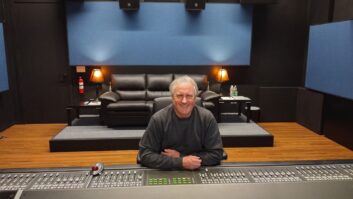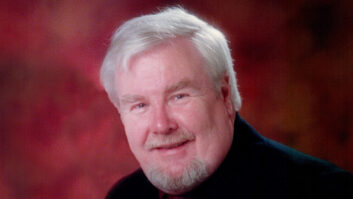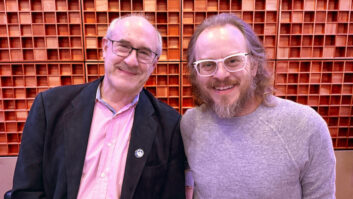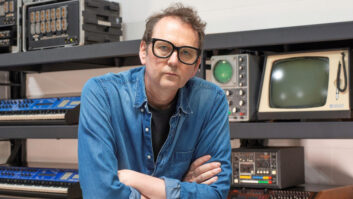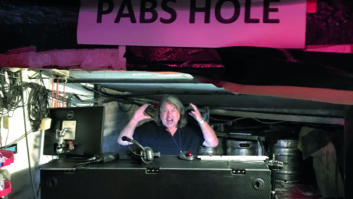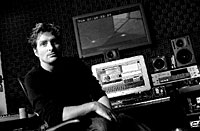
Composer Paul Hartwig has had a good run. He’s amassed a fairlyaccomplished television spot credit list for companies such asBudweiser, Coca-Cola and Best Buy; he composed 15 primary themes forthe Emmy Award — winning short film Grandfather’sBirthday; and scored the Sundance Film Festival Award —winning Bearwalker.
Yet, Hartwig is not quite satisfied. Rather than resting on hislaurels, or swimming along as the big fish in a small pond, theMinneapolis-based composer is looking forward to working in the featurefilm world and has opened a Santa Monica, Calif., studio to facilitatethe jump. “That’s where all the film work is, and really that’swhere all the TV series are,” he says. “Everything isproduced out of L.A. and it’s not going away. It’s kind of like livingin Iowa and wanting to be a downhill skier: There’s about one hill andit’s four feet high. You can’t be far away, regardless of what anyonesays. If your director calls and says, ‘I want to talk to youabout this cue. I want a meeting on the studio lot tomorrow atone,’ you’ve got to be there. There’s just no substitute to beingthere.”
To that end, Hartwig is outfitting his facility as a mirror image tothe Minneapolis studio where his steady climb from spots to series workto documentaries to features began after Limited Warranty, the band heplayed with in the ’80s, retired. His first gig as a composer was foran image piece for the University of Minnesota. Soon thereafter, hewrote spot music for Minnesota’s sports teams — Timberwolves,Twins and Vikings — and for such Minneapolis-based companies asBest Buy, 3M and Target. “There are a lot of those big companiesbased here, so I got in on the side road doing spot work,” heexplains.
Hartwig’s share of television work includes a current MGM TV series,and shows for The Learning Channel (Home Savvy) and The TravelChannel (Passport to Design). The cues he writes for the MGMseries, he explains, are very action-flavored. “It’s analog synthsounds with grinding drums, like the Dust Brothers or the ChemicalBrothers,” he says. “It’s something that has a little moregrit and grime to it, but it’s got to fit the picture, so it’s notgoing 80 miles per hour when the picture is going 20. There has to be aconnection between the picture and the music. It’s more edgy, I think,than your Hallmark special.”
He also composed the score for Poles Apart, a documentaryabout the 2000 women’s expedition to Antarctica led by Minnesotaexplorer Ann Bancroft, and a handful of shorts including New Boy,Private Eyes and Plasticity: 1.7 Number.
Even as he’s looking forward to moving into long-form, Hartwig hasfond memories of this early spot and television work. “I remembercranking out spots for Best Buy back in the days when we’d do three ina weekend,” he recalls. “It was insane. You would just kick’em out as fast as you could, [and] that kind of led into learning howto write really fast and grabbing grooves and bass lines. I use Logicand an EXS sampler and I have racks of gear, so I learned how to accesssounds fast. That really helped me in doing TV music because thedeadlines are so short.”
In addition to helping him learn how to use equipment, thosesessions helped him slip easily between genres. “It enabled meto, when I would sit down to write a cue for a film or something else,switch between classical or jazz or hip hop. I could change stylespretty quickly and easily. That took a long time to learn withoutgetting knocked down and getting bogged down with, ‘Okay, whatkind of bass line do I need?’ I think the biggest thing I learnedwas to write and then produce it. A lot of people get stuck with a basssound and spend half a day on a bass sound and then forget the ideathat they were trying to write.”
During those dates, he also learned that it was easier to write thetheme last. “I do that because I get to know the project more,and the theme is supposed to give the feeling to the wholepiece,” he reports. “If you write a chase scene, I don’tknow that you’re going to put in the thematic line.”
While he learned to write faster, that didn’t mean things cameeasily, he admits with a laugh. “I was doing a TV campaign forUnited Way for Xcel Energy, and — my client will kill me forsaying this — it was 10 minutes before the vocal session and Istill hadn’t written the lyrics. I was freaking out wondering how I wasgoing to do it and then it just kind of came to me. I had a generalunderstanding and a bunch of lines and words, but five minutes before,it just hit.”
Along the way, technology has assisted Hartwig. He’s moved up from aCommodore 64, which he used for the first University of Minnesota imagepiece, to such stalwarts as Emagic Logic Audio and Digidesign Pro ToolsMIXPlus. While he has a Yamaha C3 grand piano at home for classicalmusic cues, he mainly relies on keyboards and samplers such as RolandV-Synth, Roland VX 5050, Roland Super JV, a Proteus 2000, Waldorf MicroQ, Morpheus Z-Plane, E-mu EIV and Korg M3R, among others.
Studio A in Minneapolis is run through a Yamaha 02R console and anEmagic Logic Control. The Pro Tools MIXPlus system — an upgradeto HD is on the horizon — is stocked with a hearty assortment ofplug-ins running the gamut from Waves to Bomb Factory to IK MultimediaAmpliTube.
Inside of Logic, Hartwig relies on a bevy of instruments includingEmagic’s ES2 and EXS 24, Native Instruments’ Vokator and the VirusIndigo plug-in. “I used to have Sample Cell, but the EXS is justfabulous for being able to grab anything I need and have it sound greatin Logic,” he explains. A wide variety of sample libraries fromthe Vienna String Library to a Hans Zimmer nylon guitar are stored insix 120-gig FireWire hard drives. “If I have a Hans Zimmer— sampled nylon guitar and I can play it and then give it to aguitar player, that’s so much easier than bringing in a guitar playerand singing it and having them figure it out.
“I write on piano, score it out and then assigninstruments,” he continues. “Then I bring in sessionplayers, depending on budget, to play it. A lot of times, I had to justbring in one or two players and just get it out as quick as I couldbecause the deadlines are so short.”
Although feature deadlines aren’t much better, Hartwig is lookingforward to expanding his musical base. “I love working withorchestral arrangements and having the diversity of doing an orchestralpiece and then turning around and doing a grinding piece or a chasescene that is very tonal, and then do another piece that is very simplewith piano and yet have that same dramatic feel. I think spot work isfabulous, but it’s fun to stretch and do longer work,” hereports. “I think that’s my big motivator right now.”

